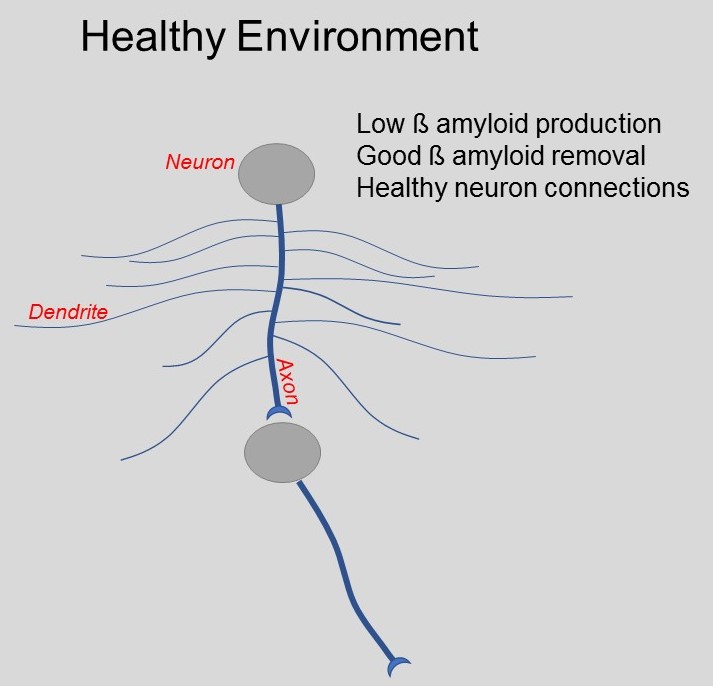
More On apoE4 and Alzheimer’s Disease Risk
May 31, 2018
-
Approximately 1 in 3 adults have either one or two copies of the apoE4 gene and therefore are at increased risk of Alzheimer’s
-
When the brain environment is “stressed”, β amyloid is produced causing this programmed downsizing by removing dendrites and thus connections to other cells which results in loss of some functions
-
The apoE4 variant does not work well in this capacity to remove this toxic protein from the brain
In a previous post we talked about apoE and the various forms such as apoE3 and apoE4 that are genetically determined. apoE is an apo protein that does several tasks such as carry cholesterol around the body. The important task regarding Alzheimer’s Disease risk is that it is also used to remove beta amyloid (β amyloid), the abnormal protein that causes the brain degeneration in Alzheimer’s, from the brain. The apoE4 variant does not work well in this capacity to remove this toxic protein from the brain.
An important concept is that the brain is always making some beta amyloid. The amount it makes is dependent on the brain’s “environment”. When the brain has low energy, is under toxic stress or has some other “environmental challenge” it produces more beta amyloid which causes neurons to lose connections with other cells and eventually to kill some brain cells also. This is referred to as “programed downsizing” during times of some sort of stressor. When the brain’s environment improves, the β amyloid is removed and the brain begins to establish more connections, “programed learning”.
The diagram below shows a healthy brain environment. The brain makes very little β amyloid in this state and what it makes it removes efficiently. The large projection from the neuron is an axon used to connect to another neuron. Along the axon there are many smaller connections called dendrites which connect the neuron to a large network of other cells.
A single neuron can establish up to about 200 connections with other neurons when in a healthy environment. This complexity of how the human brain is “wired”, is understood appreciating that there are 80 billion neurons with up to 200 connections each. This collection of 80 billion x 200 potential connections allows all the complex tasks the brain does including the formation and maintenance of memories.
When the brain environment is “stressed”, β amyloid (yellow structures) is produced causing this programed downsizing by removing dendrites and thus connections to other cells which results in loss of some functions.
Eventually with continued β amyloid build-up neurons themselves will become injured and die. At this point, significant progression in the disease occurs.
The identified factors that create the “stressed brain environment” include factors such as chronic inflammation, insulin resistance/diabetes, low hormone levels, chronic psychosocial stress and many others. Some of the most important ones are reviewed in a previous post.
Another factor in a stressed brain environment is the apoE4 variant. One of the important jobs of apoE is it is 1 of the 3 important mechanisms the brain uses to remove β amyloid. Basically, the build-up of β amyloid in the brain is the combined result of the stressors that cause excessive production and the efficiency of the removal. ApoE4 is impaired in its ability to remove β amyloid so it importantly increases disease risk.
The other two mechanisms of removing β amyloid are through insulin action and by a white blood cell called a macrophage. The ability of macrophages to remove β amyloid is dependent on the cell membrane content of omega-3 fatty acids making careful attention to their intake is important. Insulin resistance/diabetes hits both sides of the excessive production/removal balance. It causes excessive β amyloid production and impairs the ability to remove it efficiently.
The important take away about apoE is two-fold. The first part is to know what one’s genetic type is which can be obtained easily by genetic testing. The second part is to optimize lifestyle to carefully limit β amyloid production given the impaired ability the apoE4 genotype creates in removing it.
Not everyone with apoE4 will develop the disease as they may have a protective lifestyle balance. Many people without the apoE4 variant will still develop the disease as bad lifestyle/environment can still overwhelm the balance of β amyloid production/removal. Approximately 1 in 3 adults have either one or two copies of the apoE4 gene and therefore are at increased risk of Alzheimer’s.
While we do not control the genetic cards we are dealt, we do control the lifestyle environment we put our system in.
